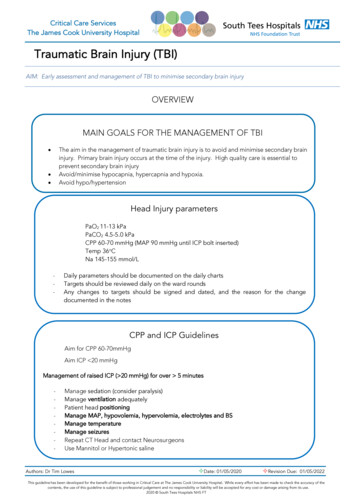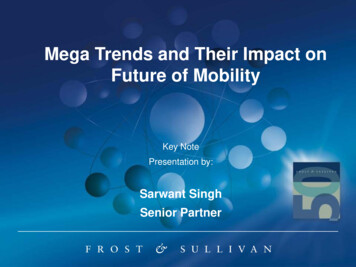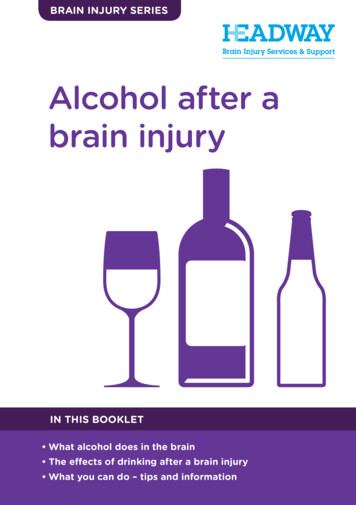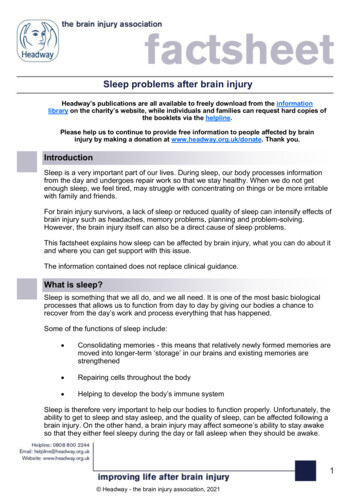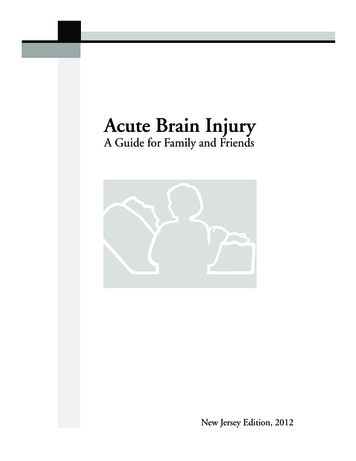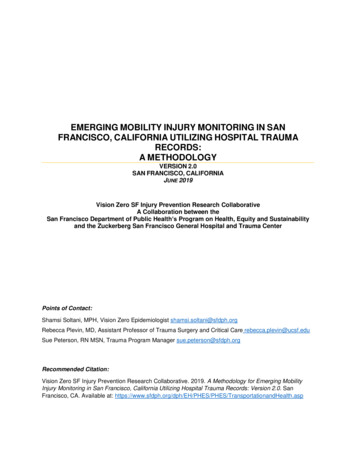
Transcription
EMERGING MOBILITY INJURY MONITORING IN SANFRANCISCO, CALIFORNIA UTILIZING HOSPITAL TRAUMARECORDS:A METHODOLOGYVERSION 2.0SAN FRANCISCO, CALIFORNIAJUNE 2019Vision Zero SF Injury Prevention Research CollaborativeA Collaboration between theSan Francisco Department of Public Health’s Program on Health, Equity and Sustainabilityand the Zuckerberg San Francisco General Hospital and Trauma CenterPoints of Contact:Shamsi Soltani, MPH, Vision Zero Epidemiologist shamsi.soltani@sfdph.orgRebecca Plevin, MD, Assistant Professor of Trauma Surgery and Critical Care rebecca.plevin@ucsf.eduSue Peterson, RN MSN, Trauma Program Manager sue.peterson@sfdph.orgRecommended Citation:Vision Zero SF Injury Prevention Research Collaborative. 2019. A Methodology for Emerging MobilityInjury Monitoring in San Francisco, California Utilizing Hospital Trauma Records: Version 2.0. SanFrancisco, CA. Available at: ionandHealth.asp
Emerging Mobility Injury Monitoring in San Francisco, California Utilizing Hospital Trauma Records: A MethodologyVersion 2.0About the Vision Zero SF Injury Prevention Research (VZIPR) CollaborativeThe VZIPR Collaborative is composed of epidemiologists, physicians, and key staff from the SanFrancisco Department of Public Health (SFDPH) and Zuckerberg San Francisco General Hospitaland Trauma Center (ZSFG). As the city’s only Level I Trauma Center, ZSFG treats nearly all patientswho sustain traumatic injuries in San Francisco, California. The VZIPR Collaborative thus has aunique opportunity to analyze the full spectrum of severe traffic injuries occurring in our city.VZIPR has been working since 2014 to develop, institutionalize, and utilize comprehensive injurydata in support of strategic research and analyses for Vision Zero SF, San Francisco's policy andcommitment to eliminate traffic deaths on city streets.The following current and former VZIPR Collaborative members, listed alphabetically by lastname, contributed to the methodology and this report:Christopher Colwell, MD, Chief of Emergency Medicine1, Professor and Vice Chair2Catherine Juillard, MD MPH, Associate Professor3Lilian H. Li, CSTR RHIT, Lead Trauma Registrar1Devan Morris, Integrated Business Systems Analyst4Adaobi Nwabuo, MBBS MPH, Injury Prevention Coordinator1Sue Peterson, RN MSN, Trauma Program Manager1Rebecca Plevin, MD, Assistant Professor of Trauma Surgery and Critical Care1, 5Eric Silverman, MD MPH, Assistant Professor of Emergency Medicine, Associate EMS Base HospitalMedical Director1,5Shamsi Soltani, MPH, Vision Zero Epidemiologist4Mimi Tam, Health Program Planner4Megan Wier, MPH, Director4Clement Yeh, MD, Medical Director6, Professor of Emergency Medicine1,21Zuckerberg San Francisco General Hospital and Trauma CenterDepartment of Emergency Medicine, University of California, San Francisco School of Medicine3Department of Surgery, University of California, Los Angeles4Program on Health Equity and Sustainability, Environmental Health Branch, San Francisco Department of PublicHealth5University of California, San Francisco6San Francisco Fire Department22
Emerging Mobility Injury Monitoring in San Francisco, California Utilizing Hospital Trauma Records: A MethodologyVersion 2.0AcknowledgementsWe would like to acknowledge our colleagues at the San Francisco Municipal Transportation Agency(SFMTA) and the San Francisco Police Department (SFPD) for their collaboration and coordination indeveloping this methodology, including Alex Demisch, Danielle Harris and James Shahamiri of theSFMTA and Commander Teresa Ewins and Captain Raj Vaswani of the SFPD. We would also like toacknowledge Christy Adams, UC Davis Health Trauma Prevention Coordinator, for her contribution toour data.Related termsmicro-mobility, last-mile transportation, light electric vehicles, shared mobility, short-term rentals,powered scooters, stand-up scooters, e-scooters, electric kick scooters, dockless scooters, transportationnetwork companiesUpdates from Version 1.0This document was originally released in January 2019. The current 2.0 version adds a “StandardizingICD-10 Codes” section to the Methodology and updates the “Reporting and Next Steps” section toreference interim reporting on preliminary data. It also adds a new point of contact, reformats the“About” section, and reformats and reorders Appendices B and C for clarity.3
Emerging Mobility Injury Monitoring in San Francisco, California Utilizing Hospital Trauma Records: A MethodologyVersion 2.0BackgroundWhat are Emerging Mobility Services and Technologies?Innovations in the transportation industry are drastically expanding the transportation optionsavailable within cities. With its proximity to Silicon Valley and reputation as a center forinnovation, San Francisco has been an epicenter for the introduction of emerging mobilityservices and technologies (EMST). EMST encompasses both new types of transportation devicesand novel technologies that facilitate sharing of these devices. EMST currently available in SanFrancisco include: Electric bicycles (e-bikes): electric assisted pedal bicyclesElectric scooters (e-scooters, powered stand-up scooters): electric powered stand-up kickscootersMotor-driven bicycles and mopeds: gasoline or electric powered sit-down vehicle with afloorboard; or gasoline powered or assisted pedal bicycleElectric skateboards (e-skateboards): electric powered board with four wheelsHoverboards/unicycles: electric powered vehicle designed to be stood upon while riding,with one or two wheelsSegway-type vehicles: electric powered, self-balancing stand up vehicle with chest- orknee-height handlebarsTransportation Network Companies (TNC, e.g. Uber, Lyft): a motor vehicle engaged inride-hail service provision through a third-party application programming interfaceAutonomous Vehicles (AVs): vehicles with partial or (in future) complete automation ofdriving activity. With ongoing development of the technology, AVs are expected to havean increasing presence as TNCs, shuttle services, and personal vehicles7.Monitoring Injuries Associated with EMSTWith the introduction of EMST in San Francisco, it became apparent that existing methods ofinjury surveillance did not capture sufficiently detailed data to analyze injuries related to thesetechnologies. At the same time, inquiries from trauma centers and transportation agenciesthroughout the country highlighted the lack of consensus surrounding data collection. The VZIPRCollaborative began efforts to modify its methods of injury surveillance in order to assess theimpact of and respond to inquiries regarding injuries related to emerging mobility modes.Trauma registry data is a critical source of injury data for new modes of transportation and canpotentially capture injuries not included in police reports. Existing surveillance of transportationrelated injuries in San Francisco utilizes San Francisco Police Department (SFPD) collision reportsas well as data entered into the trauma registry at Zuckerberg San Francisco General Hospital andTrauma Center (ZSFG). Specially trained trauma nurses abstract transportation mode data fromhospital and prehospital patient care records and enter it into the trauma registry. As the sole7Source: https://www.sfcta.org/emerging-mobility/inventory4
Emerging Mobility Injury Monitoring in San Francisco, California Utilizing Hospital Trauma Records: A MethodologyVersion 2.0level I trauma center in San Francisco, nearly all victims with severe transportation-relatedinjuries that occur in the City and County of San Francisco are treated at ZSFG. Recent researchconducted by the VZIPR Collaborative found that 29% of patients who were injured intransportation-related crashes, transported by ambulance, and required hospitalization at ZSFGwere not reported in police records. Among cyclists, this proportion was even greater at 39%8.This finding highlights the importance and utility of hospital data to understanding injurypatterns, including for new transportation modes.Prior to October 2018, the trauma registry data-entry fields allowed for transportation modes tobe classified as bicycle, motorcycle, or motor vehicle (e.g. auto, train, etc.). These categories lackthe necessary specificity to identify injuries that involve the use of EMST. In addition, a lack ofconsensus among medical providers about how to categorize EMST made collection of accuratedata challenging. Electric bicycles, for example, are categorized as motorcycles, while users ofpowered stand-up scooters are likely to be categorized as pedestrians. The VZIPR Collaborativedeveloped a new methodology for data collection in order to address these challenges.MethodologyThe VZIPR Collaborative includes the ZSFG Trauma Center, which supplies trauma registry data.Classification of transportation mode within the trauma registry relies on chart narrativesentered by healthcare providers, which are then abstracted from patient records by a dedicatedteam of nurses at ZSFG. This workflow was identified as an opportunity for improvement; byexpanding the available options for classifying mode of transportation in the trauma registrydatabase and educating healthcare providers about the importance of accurately identifyingEMST in their chart narratives, the data collected at ZSFG would be more useful for tracking andanalyzing the burden of injuries related to EMST use.We began our efforts by identifying stakeholders among Emergency Medicine and TraumaSurgery clinicians, Trauma Program Nurses and Registrars, Emergency Medical Services (EMS)providers, the SF Police Department, and the SF Municipal Transportation Agency. The resultinggroup created a list of transportation modes that was sufficiently granular to track the vehicletypes each stakeholder sees in the hospital and on city streets. These vehicle categories alsointentionally align with the California Highway Patrol’s (CHP) vehicle categories which will helpVision Zero surveillance data ultimately link hospital, EMS and police (including CHP) data. Inaddition to identifying new modes of transportation, we took the opportunity to begin collectingdata about whether the injury is related to sharing technology—i.e. accessed through an app orsharing service, inclusive of ride hail apps or an automated vehicle.8Source: nZero/Vision Zero High Injury Network Update.pdf5
Emerging Mobility Injury Monitoring in San Francisco, California Utilizing Hospital Trauma Records: A MethodologyVersion 2.0Adding Variables to the Trauma RegistryThrough this process three key questions were identified as additional trauma registry variables:1. Was a new type of transportation vehicle involved in the collision and, if so, what type?2. Was an emerging mobility service or sharing technology involved in the collision?3. Was an autonomous vehicle (AV) involved in the collision?The allowed responses for each question and guidance regarding classification of transportationdevices (including visual aids) are included in Appendix A. We modified the ZSFG trauma registryto include fields for responses to each of these questions, generating three new categoricalvariables (see Appendix B).Standardizing ICD-10-CM Codes for New Vehicle TypesBecause of the novelty of such devices and services, to date both practice and guidance onhow to capture injuries associated with EMST in medical records has lacked standardizationacross the United States.9The VZIPR team maintains that the ICD-10-CM codes which specify “other pedestrianconveyance” (V00-V09) are the best fit for purposes of tracking e-scooter associated injury– aswell as injury related to electric skateboards, hoverboards, electric unicycles, and Segway-typevehicles– within the current ICD-10 system. These codes both represent pedestrianconveyances and exist in a section which includes motorized devices among its examples. Theassociated ICD-10 codes listed in Appendix C allow for identification of other vehicle typesinvolved in collisions. Combined with the three additional trauma registry data fields shown inAppendix B, this strategy provides the most descriptive and informative data possible, absentICD-10 modifications to identify e-scooters and other novel vehicle types as unique mechanismsof injury. Given differing and incompatible surveillance strategies in other jurisdictions(including employing codes not designed to reflect a motorized type of conveyance torepresent e-scooters) there is a clear need for national or international guidelines on how bestto capture EMST for reliable comparisons across health systems and over time.Outreach and Education on New MethodologyInformation on whether an injury involved the use of EMST must be abstracted from patient carerecords created by EMS, emergency medicine, emergency nursing and trauma surgery providers.These include data on helmet usage and other injury-related factors that are abstracted as a partof the trauma data collection. These data directly reflect the information captured in the patientrecord by medical providers. Thus, a critical component to this initiative is to prioritize training9Rix, K., & Edwards, C. (2019, February 14). Improving our Understanding of Dockless Motorized ElectronicScooters [Webinar]. American Trauma Society.6
Emerging Mobility Injury Monitoring in San Francisco, California Utilizing Hospital Trauma Records: A MethodologyVersion 2.0and communication with pre-hospital and hospital staff about efforts to improve upstream datacollection.The VZIPR collaborative developed posters to display in the ambulance bay, emergencydepartment and resuscitation rooms (see Appendix D). These posters include visualrepresentations of the types of vehicles within each category. They are particularly useful forproviders who are less familiar with the differences between vehicles that look similar but arecategorized separately, such as electric and motor-driven bicycles. In order to raise awarenessabout this initiative, VZIPR representatives have led educational sessions at departmental grandrounds, faculty & staff meetings and at the Bay Area Regional Trauma Coordinating Committee(RTCC) meeting.SFPD has undergone a similar process to educate officers about existing vehicle-type categoriesand relevant regulations. They have also created a “cheat sheet” for officers with visual aidssimilar to those in Appendix D, consistent with state collision reporting categories. SFPD collisionreporting forms were updated in April 2018 with new variables to capture the involvement ofTNCs and AVs in collisions as well.Reporting and Next StepsWe implemented the changes described in this methodology in October 2018. We will reviewour six-month data to report a preliminary analysis of the burden of injury related to EMST in SanFrancisco, CA in fall 2019. Our 2018 data were employed as a part of a mid-point evaluation ofthe year-long powered scooter pilot currently underway in San Francisco, which allows twoprivate companies to make e-scooters available for rent on city streets. A more comprehensivelook at e-scooter associated collision and injury in San Francisco over the course of 2018 (a VZIPRproduct, and an appendix to the former document) is presently available.10Regional and National CollaborationAs noted earlier, national analysis of EMST-related injuries is significantly limited by the variabilityin data collection between individual trauma hospitals. This is additionally compounded by a lackof consensus on how to assign ICD-10-CM External Cause Codes to injuries involving EMST.Through an informal survey of ICD-10-CM coding for e-scooter injuries at 17 trauma hospitalsthroughout the country, we found that over thirty ICD-10 codes were used to classify injuriesinvolving e-scooters (see Appendix E11; codes used locally at ZSFG are enumerated in AppendixC). With the increasing availability and popularity of EMST vehicles in cities, inquiries about thesafety profiles of these devices are becoming commonplace. There is a clear need for acoordinated national approach to EMST-related injury surveillance in order to accurately assessthe relevant injury burden. The VZIPR Collaborative is engaged in a national dialogue with10Vision Zero SF Injury Prevention Research Collaborative. 2019. E-Scooter Collision and Injury Analysis. SanFrancisco, CA. Available at: ionandHealth.asp11 This work was spearheaded by Christy Adams, UC Davis Health Trauma Prevention Coordinator7
Emerging Mobility Injury Monitoring in San Francisco, California Utilizing Hospital Trauma Records: A MethodologyVersion 2.0stakeholders in public health and injury prevention, trauma surgery and traffic safety to addressthese issues and inform targeted recommendations for national standards. One forthcomingaction is to request the National Center for Health Statistics ICD-10-CM Coordination andMaintenance committee to revise and/or expand ICD-10 codes for incidents involving differenttypes of EMST, with an initial focus on e-scooters and e-bikes.ConclusionThe recent proliferation of EMST in urban centers across the country– and internationally–presents a unique challenge to the local and state governments who regulate them, and thehospitals and trauma centers charged with treating injuries associated with these emergingvehicle types. This methodology is a response to the need for timely and high-quality data toempirically track and better understand injuries arising from use of these formerly uncommonvehicles. It provides an opportunity to study emerging innovations and to inform data-driveninjury prevention efforts. The VZIPR Collaborative is well-poised to continue to address futureemerging mobility safety concerns with the goal of supporting safe, sustainable and equitabletransportation in San Francisco and throughout the nation.8
Emerging Mobility Injury Monitoring in San Francisco, California Utilizing Hospital Trauma Records: A Methodology v.2.0Appendix A: Additions to Trauma Registry QuestionsQuestion1)New vehicle typeAnswer choices0 None (N/A)1 Unknown2 Electric bicycle3 Powered scooter (standup)4 Moped or motor‐driven cycle5 Electric skateboard6 Hoverboard, electric unicycle, otherelectrically motorized board7 Segway‐type vehicleRide‐hail vehicle, Transportation Network8 Company car (TNCs; e.g. Uber, Lyft)9 OtherProposed Trauma Registry Additions (version 09/17/2018)Example Image
Emerging Mobility Injury Monitoring in San Francisco, California Utilizing Hospital Trauma Records: A Methodology v.2.0Appendix A: Additions to Trauma Registry Questions2)Was an emerging mobility service or sharingtechnology involved in the collision? (e.g. Lyft, Uber,Scoot, Ford GoBike, JUMP Bike, Lime, Skip, Chariot,Zipcar, City Carshare, Maven, Waymo, etc.)0 Unknown1 No2 Yes3)Was an autonomous vehicle (AV) involved in thecollision?0 Unknown1 No, conventional vehicle2 YesProposed Trauma Registry Additions (version 09/17/2018)
Emerging Mobility Injury Monitoring in San Francisco, California Utilizing Hospital Trauma Records: A Methodology v.2.0Appendix B: Screenshot of Data Entry into ZSFG Trauma Registry
Emerging Mobility Injury Monitoring in San Francisco, California Utilizing Hospital Trauma Records: A Methodology v.2.0Appendix C: ICD-10-CM Codes Used Currently at ZSFG for EMST-related InjuriesICD-10CM CodeCode descriptionV00.09XAPedestrian on foot injured in collision with other pedestrian conveyance*V00.891AFall from other pedestrian conveyance*V00.892APedestrian on other pedestrian conveyance* colliding with stationary objectV00.898AOther accident on other pedestrian conveyance*V01.09XAPedestrian with other conveyance injured in collision with pedal cycle in nontraffic edestrian with other conveyance injured in collision with pedal cycle intraffic accident (not limited to EMST-related accidents)Pedestrian with other conveyance injured in collision with two- or three-wheeled motor vehiclein nontraffic accident†Pedestrian with other conveyance injured in collision with two- or three-wheeled motor vehiclein traffic accidentPedestrian with other conveyance injured in collision with car, pick-up truck or van in nontrafficaccident†Pedestrian with other conveyance injured in collision with car, pick-up truck or van in trafficaccidentPedestrian with other conveyance injured in collision with heavy transport vehicle or bus innontraffic accident†Pedestrian with other conveyance injured in collision with heavy transport vehicle or bus in trafficaccidentPedestrian with other conveyance injured in collision with railway train or railway vehicle innontraffic accident†Pedestrian with other conveyance injured in collision with railway train or railway vehicle intraffic accidentPedestrian with other conveyance injured in collision with other nonmotor vehicle in nontrafficaccident†Pedestrian with other conveyance injured in collision with other nonmotor vehicle in trafficaccident* “Other pedestrian conveyance” includes powered scooter (stand up), electric skateboard, hoverboard,electric unicycle, Segway-type vehicle†“Nontraffic accident” refers to an incident that didn’t occur on a roadway or street
Emerging Mobility Injury Monitoring in San Francisco, California Utilizing Hospital Trauma Records: A Methodology v.2.0Appendix C: ICD-10-CM Codes Used Currently at ZSFG for EMST-related InjuriesICD-10Code descriptionCM CodeV20.4XXAMotorcycle‡ driver injured in collision with pedestrian or animal in traffic accidentV20.5XXAMotorcycle‡ passenger injured in collision with pedestrian or animal in traffic accidentV21.4XXAV21.5XXAMotorcycle‡ driver injured in collision with pedal cycle in traffic accidentMotorcycle‡ passenger injured in collision with pedal cycle in traffic accidentV23.4XXAMotorcycle‡ driver injured in collision with car, pick-up truck or van in traffic accidentV23.5XXAMotorcycle‡ passenger injured in collision with car, pick-up truck or van in traffic accidentV24.4XXAMotorcycle‡ driver injured in collision with heavy transport vehicle or bus in traffic accidentV24.5XXAMotorcycle‡ passenger injured in collision with heavy transport vehicle or bus in traffic accidentV25.4XXAMotorcycle‡ driver injured in collision with railway train or railway vehicle in traffic accidentV25.5XXAMotorcycle‡ passenger injured in collision with railway train or railway vehicle in traffic accidentV26.4XXAMotorcycle‡ driver injured in collision with other nonmotor vehicle in traffic accidentV26.5XXAMotorcycle‡ passenger injured in collision with other nonmotor vehicle in traffic accidentV27.4XXAMotorcycle‡ driver injured in collision with fixed or stationary object in traffic accidentV27.5XXAMotorcycle‡ passenger injured in collision with fixed or stationary object in traffic accidentV28.4XXAMotorcycle‡ driver injured in noncollision transport accident in traffic accidentV28.5XXAMotorcycle‡ passenger injured in noncollision transport accident in traffic accidentV87.7XXAV87.8XXAPerson injured in collision between other specified motor vehicles (traffic)Person injured in other specified noncollision transport accidents involving motor vehicle (traffic)Person injured in other specified (collision)(noncollision) transport accidents involving nonmotorvehicle (traffic)V87.9XXA‡“Motorcycle” includes: shared moped or motor scooter and e-bicycle
Emerging Mobility Injury Monitoring in San Francisco, California Utilizing Hospital Trauma Records: A Methodology v.2.0Appendix D: New Transport Modes PosterHow to Classify New Modes of TransportationWhat we’re doing: SFDPH and SFPD are working to better capture and track injuries involvingnewer vehicle types and methods of transportation access (e.g. vehicle sharing programs and app‐accessed ride hail) to inform injury prevention measures.The ask: Pre‐hospital and ER staff collect crucial information about collisions that patients may notbe able to report themselves. To assist we ask that you include any of the following terms that mayapply to a collision in the narrative description. Example images are included for clarity:Electric bicycle(or e‐bicycle, e‐bike)Powered standupscooter(or e‐scooter)Moped or motor‐driven cycleElectric skateboard(or e‐skateboard)Hoverboard, electricunicycle, otherelectrically motorizedboardSegway‐type vehicleRide‐hail vehicle,TransportationNetwork Company car(TNCs; e.g. Uber, Lyft)Autonomous vehiclePlease refer questions to shamsi.soltani@sfdph.orgVersion 12/12/2018
Emerging Mobility Injury Monitoring in San Francisco, California Utilizing Hospital Trauma Records: A Methodology v.2.0Appendix E: ICD-10-CM Codes Currently Used Regionally for e-Scooter XXAV87.8XXAPedestrian on foot injured in collision with other pedestrian conveyanceFall from scooter (nonmotorized)Scooter (nonmotorized) colliding with stationary objectOther scooter (nonmotorized) accidentFall from other rolling-type pedestrian conveyancePedestrian on other rolling-type pedestrian conveyance colliding with stationary objectOther accident on other rolling-type pedestrian conveyanceFall from other flat-bottomed pedestrian conveyanceFall from other flat-bottomed pedestrian conveyancePedestrian on other flat-bottomed pedestrian conveyance colliding with stationary objectOther accident on other flat-bottomed pedestrian conveyanceFall from motorized mobility scooterMotorized mobility scooter colliding with stationary objectFall from other pedestrian conveyancePedestrian on other pedestrian conveyance colliding with stationary objectOther accident on other pedestrian conveyancePedestrian with other conveyance injured in collision with pedal cycle in non- trafficaccidentPedestrian with other conveyance injured in collision with pedal cycle in traffic accidentPedestrian with other conveyance injured in collision with car, pick-up truck or van in trafficaccidentPedestrian with other conveyance injured in collision with heavy transport vehicle or bus intraffic accidentPedestrian with other conveyance injured in collision with railway train or railway vehiclein traffic accidentPedestrian with other conveyance injured in collision with other nonmotor vehicle,unspecified whether traffic or nontraffic accidentMotorcycle driver injured in collision with car, pick-up truck or van in nontraffic accidentMotorcycle driver injured in collision with car, pick-up truck or van in traffic accidentUnspecified motorcycle rider injured in collision with fixed or stationary object in nontrafficaccidentMotorcycle passenger injured in noncollision transport accident in nontraffic accidentMotorcycle driver injured in noncollision transport accident in traffic accidentPerson injured in collision between other specified motor vehicles (traffic)Person injured in other specified noncollision transport accidents involving motor vehicle(traffic)Person injured in other specified (collision)(noncollision) transport accidents involvingnonmotor vehicle (traffic)Person injured in collision between other specified motor vehicles (traffic)Person injured in other specified noncollision transport accidents involving motor vehicle(traffic)
level I trauma center in San Francisco, nearly all victims with severe transportation-related injuries that occur in the City and County of San Francisco are treated at ZSFG. Recent research conducted by the VZIPR Collaborative found that 29% of patients who were injured in transportation-related crashes, transported by ambulance, and required .
